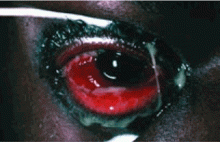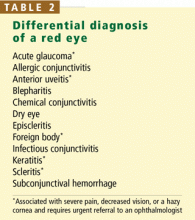Bacterial conjunctivitis: A review for internists
ABSTRACTBacterial conjunctivitis is common and occurs in patients of all ages. Typical signs are a red eye and purulent drainage that persists throughout the day. Gonococcal and chlamydial conjunctivitis must be treated with systemic antibiotics. Bacterial conjunctivitis due to most other organisms can be treated empirically with topical antibiotics. Red flags suggesting a complicated case requiring referral to an ophthalmologist include reduced vision, severe eye pain, a hazy-appearing cornea, contact lens use, and poor response to empirical treatment.
KEY POINTS
- Viral conjunctivitis typically presents as an itchy red eye with mild watery discharge. Many patients have signs and symptoms of a viral upper respiratory tract infection (eg, cough, runny nose, congestion) and have been in contact with a sick person.
- Having both eyes glued shut in the morning had an odds ratio of 15:1 in predicting a positive bacterial culture, whereas either itching or previous conjunctivitis made a bacterial cause less likely.
- In adults, Neisseria gonorrhoeae causes hyperacute conjunctivitis and is associated with concurrent, often asymptomatic genital infection. Gonococcal conjunctivitis should be treated with a single dose of ceftriaxone (Rocephin) 1 g intramuscularly plus saline eye-washing.
- Corticosteroid drops should not be prescribed for a red eye before consultation with an ophthalmologist because these drops may worsen some conditions.
CLINICAL FEATURES OF BACTERIAL CONJUNCTIVITIS
Bacterial conjunctivitis is commonly classified according to its clinical presentation: hyperacute, acute, or chronic.
Hyperacute bacterial conjunctivitis presents with the rapid onset of conjunctival injection, eyelid edema, severe, continuous, and copious purulent discharge, chemosis, and discomfort or pain.
N gonorrhoeae is a frequent cause of hyperacute conjunctivitis in sexually active patients; the patient usually also has N gonorrhoeae genital infection, which is often asymptomatic. N gonorrhoeae conjunctivitis also occurs in neonates, as noted above. The cornea is frequently involved, and untreated cases can progress within days to corneal perforation. Unlike most other types of conjunctivitis, gonococcal conjunctivitis should be treated as a systemic disease, with both systemic and topical antibacterial therapy.2
Acute bacterial conjunctivitis typically presents abruptly with red eye and purulent drainage without significant eye pain, discomfort, or photophobia. Visual acuity does not typically decrease unless large amounts of discharge intermittently obscure vision.
Chronic bacterial conjunctivitis, ie, red eye with purulent discharge persisting for longer than a few weeks, is generally caused by Chlamydia trachomatis or is associated with a nidus for infection such as in dacryocystitis.
BACTERIAL CONJUNCTIVITIS VS OTHER CAUSES OF A RED EYE
Clinical signs and symptoms of infection with certain organisms have been extensively described, but a meta-analysis17 found no evidence that these textbook features help to distinguish between bacterial and viral causes of conjunctivitis. Instead, whether a bacterial cause was likely was best determined from just three features: having both eyes glued shut in the morning had an odds ratio of 15:1 in predicting a positive bacterial culture, and either itching or previous conjunctivitis made a bacterial cause less likely.18
In general, however, viral conjunctivitis typically presents as an itchy red eye with mild watery discharge. Many patients have signs and symptoms of a viral upper respiratory tract infection (eg, cough, runny nose, congestion) and have been in contact with a sick person. Ipsilateral preauricular lymphadenopathy is common in viral conjunctivitis and strongly suggests this diagnosis.19
Viral conjunctivitis is often epidemic and is easily contagious. Several epidemics have been traced to eyecare facilities. Adenovirus conjunctivitis is extremely contagious and can be transmitted both between people and via inanimate objects; it has been reported to be spread by workers in health care facilities.20
Allergic conjunctivitis is also common. Patients typically report itching and redness of both eyes in response to an allergen exposure. Other allergic symptoms may be present, such as allergic rhinosinusitis, asthma, or atopic dermatitis in response to seasonal or perennial environmental allergens.
Other causes of a red eye. Many patients with a red eye have conjunctivitis, but other conditions can also present in a similar manner. Whether a patient has a serious vision-threatening condition (eg, acute-angle closure glaucoma, microbial keratitis, or anterior uveitis) can usually be determined with a focused ophthalmologic history and physical examination. Any alarming clinical features such as severe pain, decreased vision, or a hazy cornea in a patient with a red eye should alert the clinician to a more serious condition and prompt a referral to an ophthalmologist for an urgent evaluation (Table 2). A complete review for internists on how to manage a red eye was recently published in this journal.21
TREATMENT
Systemic treatment needed for gonococcal or chlamydial infections
The US Centers for Disease Control and Prevention recommend treating gonococcal conjunctivitis with ceftriaxone (Rocephin) 1 g in a single intramuscular dose plus topical saline lavage of the eye.22,23 Sexual partners of the patient should be referred for evaluation and treatment, as should mothers of affected neonates and the mother’s sexual partners.
Chlamydial conjunctivitis is also treated with systemic antibiotics. In neonates, the treatment is the same as for pneumonia caused by C trachomatis: erythromycin taken orally for 14 days. In adults, it can be treated with a single oral dose of azithromycin (Zithromax) 1 g.
Some authors recommend that H influenzae conjunctivitis also be treated with systemic antibiotics, as it is frequently associated with concurrent otitis media.24








